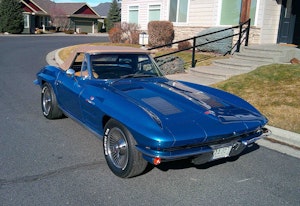Media | Articles
Seven Corvette features and models we love
Sometimes it’s easy to criticize those we hold dearest. We previously published a list of seven Chevy Corvette features and models that we don’t love and found that while many agreed, some didn’t: We’re looking at you, t-top owners. Becoming America’s sports car wasn’t easy, and as such, the Corvette is expected to maintain world-class performance and terrific value. But sometimes the risks that Chevrolet’s designers and engineers take don’t pan out. More often than not, however, they did have winning ideas. Following are seven Corvette models and features that we have come to love.
-
Independent Rear Suspension
The split-window Corvette was gorgeous. But it wasn’t the second-gen’s true hero. What really revolutionized the C2 was the vastly superior suspension hidden beneath the beautiful exterior. The first generation Corvette, while nimble in its own right, was falling behind its sports car rivals from Europe. Father of the Corvette, Zora Arkus-Duntov, was aware of the passing competition and planned to include the independent rear in the upcoming redesign. GM’s single-seat development mule, CERV I, provided the basis for the Corvette’s first IRS. The new suspension, along with a shift to a more rear-biased weight distribution, vastly improved the new-for-1963 Corvette. Even more impressive, the signature transverse-mounted leaf spring, introduced in 1963, has evolved with each subsequent generation and endures on the C7.
-
Targa Top
The second iteration of the Corvette’s removable roof offered an improved solution to the open-air dilemma. The genius of the design lies in its storage—drivers desiring a wind-in-your-hair experience can easily pull over, remove the roof and store it in the wide trunk opening. The transition from T-tops to a one-piece unit also meant that the roof opening became larger, more closely approaching a convertible. Since its introduction on the C4, the targa has become the Corvette’s most popular bodystyle—just don’t let their rivals at Porsche know.
-
Head-Up Display
Enthusiasts notice whenever an automaker incorporates fighter-jet technology into their sports car. First offered in 1998, the head-up display (HUD) projects speed, RPM and lateral grip data directly ahead of the driver on the windshield. Current versions of the HUD allow for customized displays and even multiple color options, rather than the single original hue, “microwave-clock green.” In a car capable of over 170 mph, a Top Gun-style feature that keeps your eyes on the road is certainly desirable. Now where’s that ejector seat option?
-
C4 Grand Sport
Often the best solution to a problem is also the simplest. Team Corvette originally solved their early ‘90s performance quandary through the use of four cams, 32 valves and a $60,000 price tag. However, the 1996 Grand Sport went back to basics with a tuned 330-hp LT-4 small block V-8. It produced 90 percent of the performance for about half the ZR-1’s cost. The GS not only saved buyers money, but offered the exclusivity of just 1000 being produced—compared to the 6900 ZR-1s built. The paint selection was also limited and hopefully you’re patriotic because the only available color scheme is Admiral Blue with a fat Arctic White stripe down the middle and two red hashmarks on the left fender. With current Grand Sport values steadily outpacing the King Of The Hills’, it’s safe to say that sometimes less really is more.
-
Big Block
Big Block, big impact. For an engine that only stuck around 10 years, it sure gathered a massive following. So large, in fact, that these cars easily hold the title of the most collectable Corvette models available. What began as a low-cost horsepower solution to the more complicated 327-cid Fuelie, ended up converting the Corvette from a balanced sports car into a muscular drag racer. Engine aficionados will also note that ‘Vette-spec Mark IV Big Blocks came in three displacement configurations: 396-cid, 427-cid and 454-cid. Their personalities range from lopey cruiser to thinly-disguised race engine. With lineage including powerhouses such as the L88, L89, ZL1, and LS6, it’s no wonder that Big Block Corvettes achieved hallowed status.
-
Z06
The option code that became an icon. When GM suddenly banned company sponsorship of racing teams in the early ‘60s, each brand was forced to find ways to keep excitement in their lineup. Knowing full well that those with 100-octane in their veins would continue campaigning the car, Duntov again had the answer. Regular Production Option Z-06 was created to supply racers with go-fast equipment while cleverly tip-toeing around the General’s decree. Features included heavy-duty brake equipment, stiffer suspension, and the famed big fuel tank. The option certainly left its mark, enough to return in 2001 as a full-fledged, 385-hp stand-alone model and again for the sixth and seventh generation ‘Vettes. Today, it reigns as the top-of-the-line track monster, featuring 650 supercharged horsepower. It’s safe to assume that Zora would be proud.
-
Small Block
Chevrolet’s Small Block V-8 saved the Corvette. Claiming otherwise would be wrong. By 1954’s end, the car’s future was looking increasingly bleak, but two lucky events put it back on the map: Ford launched its competing Thunderbird, and Chevrolet introduced their first V-8. Duntov’s influence prevailed once again, as outlined in his bold letter to Chief Engineer Ed Cole. As we know the Corvette didn’t die, but adopted the groundbreaking Small Block and took the fight back to Ford. And the mouse motor fought hard, solidifying the C1’s sports car status by steadily increasing power and refinement. With 455 hp from today’s base V-8, the original Blue Flame Six seems downright asthmatic. Luckily the cure arrived in 1955, as the new V-8 was just what the doctor ordered.
What are your favorite Corvette models and features? Let us know in the comments below.
Marketplace
Buy and sell classics with confidence










